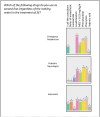An Italian Survey on the Management of Pediatric Convulsive Status Epilepticus: More Than Just a Pharmacological Choice
- PMID: 40165501
- PMCID: PMC11959095
- DOI: 10.1002/brb3.70433
An Italian Survey on the Management of Pediatric Convulsive Status Epilepticus: More Than Just a Pharmacological Choice
Abstract
Background and purpose: To explore specialists' opinions on the current management of pediatric convulsive status epilepticus (CSE) in Italy and the main factors influencing the applicability of guidelines.
Methods: We conducted a national survey of child neurologists, pediatric emergency physicians, and intensivists. Within the multidisciplinary Italian Paediatric Status Epilepticus (IPSE) Group, a web-based 48-multiple-choice questionnaire was developed to explore treatment choices, use of internal protocols and guidelines, and self-perceived competencies in the treatment of CSE.
Results: Responses were received from 250 clinicians from 34 Italian hospitals (response rate 71%). Intravenous midazolam (iv-MDZ) was the preferred benzodiazepine (BDZ) when iv access was available (90%). When iv-access was unavailable, 75% of clinicians used BDZs; rectal diazepam was the most indicated (65.6%). Concerning second-line treatment, the choices were equally distributed between phenytoin (55.2%), levetiracetam (52.4%), and phenobarbital (52.4%). MDZ infusion at a dosage < 0.23 mg/kg/h was also a frequent choice (38%). A PICU in the hospital influenced this latter choice, resulting in a significantly greater use of iv-MDZ by pediatric emergency physicians working in these hospitals. Answers' variability was related to organizational aspects such as the availability of on-duty specialists and diagnostic tools in emergency settings.
Conclusions: This survey confirmed that first-line treatment of pediatric CSE relied on iv-MDZ and that the heterogeneity of therapeutic choices started from the second-line treatment in real life. The survey also highlighted the need to consider the organizational heterogeneity among settings and to involve different specialties in an integrated and feasible approach.
Keywords: intensive care unit; pediatric; status epilepticus; survey; treatment.
© 2025 The Author(s). Brain and Behavior published by Wiley Periodicals LLC.
Conflict of interest statement
The authors declare no conflicts of interest.
Figures



Similar articles
-
A multicentre randomised controlled trial of levetiracetam versus phenytoin for convulsive status epilepticus in children (protocol): Convulsive Status Epilepticus Paediatric Trial (ConSEPT) - a PREDICT study.BMC Pediatr. 2017 Jun 22;17(1):152. doi: 10.1186/s12887-017-0887-8. BMC Pediatr. 2017. PMID: 28641582 Free PMC article. Clinical Trial.
-
Survey About Second-Line Agents for Pediatric Convulsive Status Epilepticus.Pediatr Emerg Care. 2023 Apr 1;39(4):247-252. doi: 10.1097/PEC.0000000000002745. Epub 2022 May 5. Pediatr Emerg Care. 2023. PMID: 35510724
-
Treatment of generalized convulsive status epilepticus: An international survey in the East Mediterranean Countries.Seizure. 2020 May;78:96-101. doi: 10.1016/j.seizure.2020.03.016. Epub 2020 Apr 10. Seizure. 2020. PMID: 32315955
-
Treatment of convulsive status epilepticus in infants and young children in Japan.Acta Neurol Scand Suppl. 2007;186:62-70. Acta Neurol Scand Suppl. 2007. PMID: 17784539 Review.
-
Treatment of convulsive status epilepticus in childhood: recommendations of the Italian League Against Epilepsy.Epilepsia. 2013 Oct;54 Suppl 7:23-34. doi: 10.1111/epi.12307. Epilepsia. 2013. PMID: 24099053 Review.
References
-
- Appleton, R. E. 2020. “Second‐Line Anticonvulsants for Paediatric Convulsive Status Epilepticus.” Lancet 395, no. 10231: 1172–1173. - PubMed
-
- Babl, F. E. , Sheriff N., Borland M., et al. 2009. “Emergency Management of Paediatric Status Epilepticus in Australia and New Zealand: Practice Patterns in the Context of Clinical Practice Guidelines.” Journal of Paediatrics and Child Health 45, no. 9: 541–546. - PubMed
-
- Bacon, M. , Appleton R., Bangalore H., et al. 2023. “Review of the New APLS Guideline (2022): Management of the Convulsing Child.” ADC Education & Practice 108, no. 1: 43–48. - PubMed
-
- Brophy, G. M. , Bell R., Claassen J., et al. 2012. “Guidelines for the Evaluation and Management of Status Epilepticus.” Neurocritical Care 17: 3–23. - PubMed
-
- Cao, Y. , Li H., Chen M., et al. 2024. “Evaluation and Systematic Review of Guidance Documents for Status Epilepticus.” Epilepsy & Behavior 150: 109555. - PubMed
MeSH terms
Substances
LinkOut - more resources
Full Text Sources

